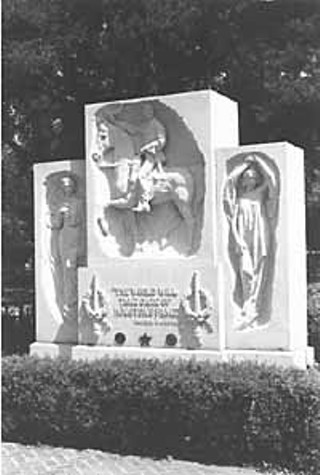Day Trips
Huntsville ... it's more than just a prison town!
By Gerald E. McLeod, Fri., Jan. 21, 2000

Huntsville was the last home and final resting place of Sam Houston. A man who traveled extensively around the United States and Texas, General Sam chose this spot for its beauty and fertile soil. The town is still a jewel in the thick East Texas forest.
There isn't much that the hero of San Jacinto would recognize in the Huntsville of today. Although much of the piney woods around town have been preserved as the Sam Houston National Forest, the Indian trading post is now a grown city with a major university, the center of the state's prison system, a vibrant downtown, and plenty of wilderness areas in the surrounding countryside.
Houston and his wife Margaret Lea lived in Huntsville off and on over a period of nearly 20 years. When he wasn't involved with Texas government, the old general practiced law in a one-room log cabin behind his home. Houston died in Huntsville on July 26, 1863.
Sam Houston is big in Huntsville. Nowhere is he larger than on the south side of town off of I-45, where his statue rises 77 feet above the pine needle-covered red earth. Installed in 1994, the sculpture is the largest in the U.S. memorializing a real-life figure. The only statue bigger is the giraffe at the gates of the Dallas Zoo (by about four inches).
The 30-ton concrete statue is quite a sight, especially at night when it's illuminated. From six miles away, northbound travelers are welcomed by the illusion that the general is standing in the middle of the freeway. At the base of the monument, the city of Huntsville operates a visitor center and small park.
To go from the visitor center to downtown Huntsville, take I-45 north to the 19th Street exit and go east. A few blocks from the interstate, the park-like grounds of the Sam Houston Memorial Museum complex fills an area the size of six city blocks.
On land that was once Houston's farm, the centerpiece of the park is his woodland home and law office. The Steamboat House where Houston died was moved to the site and the museum was built for the state's centennial celebration in 1936. The campus of Sam Houston State University sits on the hill overlooking the Houston park.
The Walker Education Center on 19th Street is the place to begin a tour of the grounds. Besides a gift shop, the center houses rotating exhibits and an auditorium with a brief introductory film about Houston. The grounds are also the site of the General Sam Houston Folk Festival to be held April 14-16.
North of 19th Street, Sam Houston Avenue leads to the courthouse. Originally called Market Square, the current Walker County Courthouse was built after the 1888 courthouse burned on Christmas Eve in 1968. The architecture surrounding the square reflects the charm of small-town Texas.
Many of the businesses on the square cater to visitors. Antique and gift shops fill a number of the storefronts. One business, King's at 112 11th St., has been a favorite pause for visitors since 1927. The candy factory and soda fountain are still run by members of the King family. Along with 30 kinds of candies, ice cream, and homemade lemonade, the Kings make a chicken salad sandwich that many locals swear is the best in the West.
Across the courthouse square is another tradition, but it is not quite as old. Since 1936, the Cafe Texan has been serving chicken fried steaks and a pepper steak that folks will drive for miles to get. The cafe at 1120 Sam Houston Ave. retains the look, the service, and the quality of bygone days. This is probably the town's favorite coffee shop.
Across the street from the Cafe Texan is one of the spookiest museums in Texas. Opened in 1989, the Texas Prison Museum, 1113 12th St., will scare most visitors away from a life of crime. The showcases are full of homemade weapons confiscated from the inmate population and other violent paraphernalia. If the six-by-nine-foot death row cell doesn't make the hair on the back of your neck stand on end, then the 1924 electric chair, affectionately called "Old Sparky," surely will give you a cold chill.
There are several campgrounds and parks with hiking and biking trails around Huntsville, but the most popular is Huntsville State Park. The picturesque Lake Raven in the center of the park attracts visitors for fishing and water sports, but the miles of hike and bike trails are equally attractive.
The Huntsville area is a great place to explore. The Lone Star Hiking Trail is a few miles northeast of town. The Samuel Walker Houston Museum, named for the statesman son of a Houston ex-slave and not to be confused with the more famous Sam Houston, is a rare repository of African-American history. There also are several very nice bed and breakfast inns and resorts in the area. For more tips on beginning your exploration contact the chamber of commerce at 800/289-0389 or at http://www.chamber.huntsville.tx.us/tourism.html.
There is one more thing I have to tell you about if you love your barbecue juicy and spicy: Check out the smoked meats at the New Zion Missionary Baptist Church a couple of miles south of the town square, at 2601 Montgomery St. The business started as a fundraiser for the church next door and has been drawing visitors back for 20 years. Open Tuesday through Saturday, after one visit you'll be singing the praises of their barbecue. Don't forget to get a piece of pie, even if you have to save it for later.
Coming up this weekend ...
Sam Bass Treasure Hunt/Mystery Game searches the deep corners of Longhorn Cavern, Jan. 21-22. 512/756-4680.
Eagle Fest in Emory celebrates the visiting bald eagles with a variety of events and takes visitors to Lake Fork looking for the national symbol, Jan. 21-22. 903/473-3913.
Coming up ...
Wilderness First Responder Course presented by Wilderness Medical Associates gives graduates the skills to deal with medical emergencies when dialing 911 is not an option, Mar. 23-Apr. 23. 214/887-1822 or http://www.wildmed.com.








